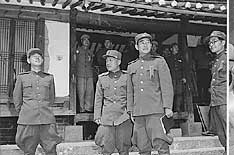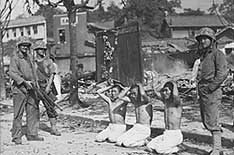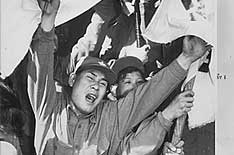On July 10, 1951, peace talks began between the U.N. and North Korea in the village of P’anmunjom, just north of the future Demilitarized Zone (DMZ). At the center of the talks would be the question of prisoners-of-war.
Both sides had committed atrocities against POWs. The U.S. charged that American POWs had been starved, subjected to political brainwashing sessions, and randomly executed. Throughout the war, speeches by American POWs calling for an end to hostilities had been broadcast. U.S. military sources indicated that roughly 38 percent of all U.S. prisoners-of-war died in captivity.
Meanwhile, Chinese and North Korean POWs experienced their own difficulties. Until the UN attempted to regulate prison camps, enemy soldiers caught by South Korean forces were often summarily shot . . . or worse. Even with some order imposed, cramped quarters, initially inadequate food, and frequent camp fights and uprisings between prisoners who did want to be returned to communist-held territory and those who did not were commonplace. In the UN camp on Koje-do island, the camp commander was taken prisoner by POWs, who demanded that he issue a statement about the inhumane treatment of detainees. By early 1952, the POW camps were in full uproar.
To resolve the issue of POWs who refused repatriation, North Korea agreed to a system of UN camps that would hold the detainees for three months before the POWs made a final decision. Reportedly, North Korean prisoners who did opt to return home threw away clothes, shoes, chocolate, cigarettes, anything that they’d been given before the exchange.
But parting salvos had yet to be fired. Two final attempts by China and the North to gain territory failed. A PR campaign to charge the U.S. and UN with germ warfare on North Korean and Manchurian territory proved more successful. The U.S., for its part, destroyed irrigation dams that provided 75 percent of the water for the North’s farms. Meanwhile, the death of Soviet leader Joseph Stalin in March 1953 made the USSR’s begrudging shipments of military supplies to Mao and Kim’s forces even more uncertain.
On July 27, 1953, an armistice agreement was signed by the UN, North Korea, and China. South Korea, outraged that a cease-fire had come without the unification of Korea, refused to sign, but agreed to abide by its terms. Under the terms of the agreement, both sides withdrew two kilometers (about 1.3 miles) from the border, creating the Demilitarized Zone that is patrolled to this day.
The three years of war had killed an estimated 3 million Koreans, most of them civilians, and made an estimated 5 million refugees. Losses to foreign forces were also immense: nearly 1 million Chinese troops, 33,700 U.S. troops, and a few thousand troops from 15 UN member-states died in the fighting.
North Korea claims the war killed some 405,000 U.S. troops and avoids mention of China’s contribution.
- Previous: Fall 1950 China Responds
- Next: 1953 – Present The After...





